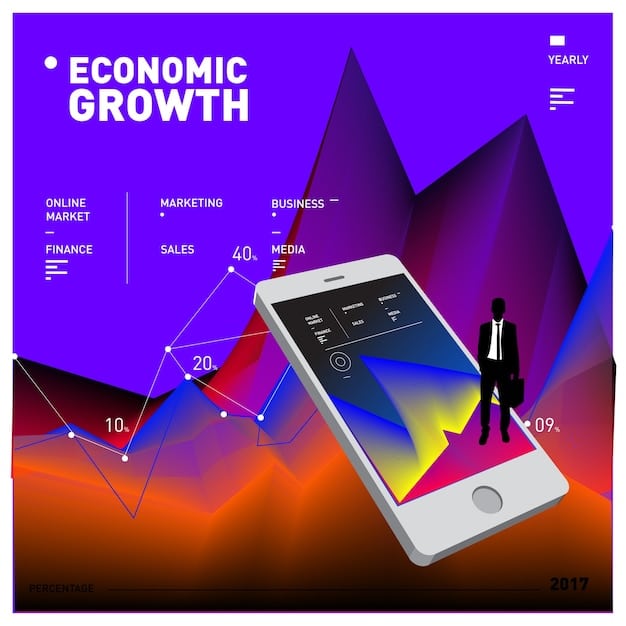Maximize ROI: Targeted Mobile Ad Campaigns on Social Media in the US

Mobile advertising, when strategically executed through targeted campaigns on social media platforms in the US, offers a powerful avenue to maximize return on investment by reaching specific demographics with tailored messaging.
Want to amplify your marketing efforts and see a significant return on investment? Dive into the world of mobile advertising, specifically how targeted mobile ad campaigns on social media platforms in the US can revolutionize your approach.
Understanding the US Mobile Advertising Landscape
Mobile advertising has become a cornerstone of digital marketing strategies in the United States. Understanding its dynamics is crucial for businesses aiming to connect with their target audience effectively.
The US mobile market is characterized by high smartphone penetration and a diverse user base, making it a fertile ground for targeted advertising campaigns.
The Rise of Mobile Commerce
Mobile commerce, or m-commerce, has seen explosive growth in recent years, driven by the convenience and accessibility offered by smartphones and tablets. This shift has created new opportunities for businesses to engage with customers directly through mobile advertising.
Consumers are increasingly using their mobile devices to research products, compare prices, and make purchases, making mobile advertising an indispensable tool for reaching them at every stage of the buying process.
- Mobile-First Indexing: Google prioritizes mobile-first indexing, meaning websites are primarily evaluated based on their mobile versions.
- Location-Based Targeting: Mobile advertising enables precise targeting based on location, allowing businesses to reach customers in specific geographic areas.
- Personalized Ads: Mobile data allows for personalized ad experiences, increasing engagement and conversion rates.

In conclusion, a deep understanding of the US mobile advertising ecosystem, including the rise of m-commerce and the evolving preferences of mobile users, is essential for crafting effective and ROI-driven campaigns.
Identifying Your Target Audience in the US
Successful mobile advertising hinges on identifying and understanding your target audience. This involves segmenting the US population based on various factors to ensure your message resonates with the right people.
By defining your ideal customer profile, you can tailor your ad campaigns to their specific needs and preferences, significantly increasing engagement and conversion rates.
Demographic and Psychographic Segmentation
Demographic segmentation involves categorizing your audience based on factors like age, gender, income, education, and location. Psychographic segmentation, on the other hand, focuses on understanding their values, interests, lifestyle, and attitudes.
Combining both demographic and psychographic data provides a comprehensive view of your target audience, enabling you to create more personalized and effective ad campaigns.
- Age Groups: Different age groups respond to different messaging and platforms.
- Income Levels: Understanding income levels helps in targeting ads with appropriate pricing and product offerings.
- Interests and Hobbies: Targeting based on interests and hobbies ensures that your ads are relevant and engaging.
Ultimately, precise audience identification is the bedrock of effective mobile advertising. Crafting segmented messaging that resonates with specific demographics and psychographics is the surest way to maximize ROI and drive meaningful business outcomes.
Crafting Compelling Mobile Ad Creatives
The creative aspect of mobile advertising is paramount. Compelling ad creatives are essential to capture attention, convey your message effectively, and drive user engagement on various social media platforms in the US.
High-quality visuals, concise copy, and clear calls to action are key components of successful mobile ad creatives.
Visuals and Video Content
Visually appealing images and videos are crucial for grabbing the user’s attention within seconds. High-resolution graphics and professionally produced video content can significantly enhance the impact of your mobile ads.
Consider using user-generated content (UGC) to add authenticity and credibility to your ads, as consumers often trust recommendations from other users more than branded content.
Clear, concise copy is vital for conveying your message quickly and effectively. Mobile users are often on the go, so your ad copy must be easily digestible and immediately understandable.
- Use High-Quality Images: Ensure images are sharp, relevant, and visually appealing.
- Create Engaging Video Ads: Videos should be short, attention-grabbing, and optimized for mobile viewing.
- Write Concise Copy: Get straight to the point with clear and compelling messaging.

In summary, crafting stellar mobile ad creatives requires an astute blend of visual appeal, clear messaging, and strategic calls to action. These elements, when executed effectively, can transform your ads from mere impressions into high-impact engagements that drive conversion and ROI.
Leveraging Social Media Platforms for Mobile Ads
Social media platforms offer unparalleled opportunities for mobile advertising in the US. Each platform has its own unique user base and advertising capabilities, making it essential to choose the right platforms for your target audience.
Strategic use of social media advertising can significantly amplify the reach and impact of your mobile ad campaigns.
Facebook and Instagram Advertising
Facebook and Instagram are two of the most popular social media platforms in the US, offering robust targeting options and diverse ad formats. Their extensive user data allows for precise audience segmentation based on demographics, interests, and behaviors.
Consider using carousel ads, video ads, and story ads to engage users and showcase your products or services in visually appealing ways.
Twitter and LinkedIn Advertising
Twitter and LinkedIn cater to more specific audiences. Twitter is ideal for real-time engagement and news-driven content, while LinkedIn is best for targeting professionals and businesses.
Use Twitter to promote events, share industry insights, and engage in conversations with your target audience. Leverage LinkedIn to reach decision-makers and promote your B2B offerings.
- Facebook: Ideal for broad reach and diverse targeting options.
- Instagram: Best for visually appealing content and targeting younger demographics.
- Twitter: Suited for real-time engagement and news-driven campaigns.
- LinkedIn: Effective for reaching professionals and promoting B2B solutions.
To summarize, strategic alignment of your mobile advertising efforts with the distinct capabilities of each social media platform is crucial for optimizing reach, engagement, and ultimately, ROI. Tailoring your approach to suit the demographic and behavioral nuances of each platform ensures your message resonates effectively with the intended audience.
Measuring and Analyzing ROI of Mobile Ad Campaigns
Measuring and analyzing the return on investment (ROI) of your mobile ad campaigns is essential for optimizing your strategies and maximizing your marketing spend. Tracking key metrics provides valuable insights into the performance of your ads.
Regularly monitoring and analyzing ROI helps you identify what’s working, what’s not, and where to make adjustments to improve your results.
Key Performance Indicators (KPIs)
Key performance indicators (KPIs) are specific, measurable metrics that indicate the success of your mobile ad campaigns. Common KPIs include click-through rates (CTR), conversion rates, cost per acquisition (CPA), and return on ad spend (ROAS).
Tracking these KPIs allows you to assess the effectiveness of your ad creatives, targeting strategies, and platform choices.
Tools and Techniques for ROI Analysis
Utilize analytics tools like Google Analytics, Facebook Ads Manager, and other platform-specific dashboards to track and analyze your mobile ad performance. These tools provide detailed data on user behavior, ad engagement, and conversion metrics.
Implement A/B testing to compare different ad creatives, targeting options, and landing pages to identify the most effective combinations for driving ROI.
- Click-Through Rate (CTR): Measures the percentage of users who click on your ad.
- Conversion Rate: Tracks the percentage of users who complete a desired action after clicking on your ad.
- Cost Per Acquisition (CPA): Calculates the cost of acquiring a new customer through your ad campaign.
- Return on Ad Spend (ROAS): Determines the revenue generated for every dollar spent on advertising.
In concise terms, meticulous measurement and analysis of ROI is vital for refining your mobile advertising strategies. Leveraging KPIs and analytics tools ensures you have a data-driven approach to understanding and optimizing campaign performance, leading to significant improvements in financial returns.
Optimizing Mobile Ad Campaigns for Better ROI
Optimizing your mobile ad campaigns is an ongoing process that involves continuous testing, analysis, and refinement. By making iterative improvements based on performance data, you can significantly boost your ROI.
Regularly optimizing your campaigns ensures that you are reaching the right audience with the right message at the right time.
A/B Testing and Iterative Improvements
A/B testing involves creating multiple versions of your ads with slight variations and comparing their performance. This allows you to identify which elements resonate best with your target audience and drive the most conversions.
Iterative improvements involve making incremental changes to your ad creatives, targeting options, and landing pages based on the results of your A/B tests.
- Continuously Test Ad Creatives: Experiment with different images, videos, and copy to find the most engaging combinations.
- Refine Targeting Options: Adjust your audience targeting based on performance data to reach the most receptive users.
- Optimize Landing Pages: Ensure your landing pages are mobile-friendly, relevant, and optimized for conversions.
In sum, the pathway to higher ROI lies in relentless optimization driven by continuous testing and iterative improvement. Consistently challenging your ads, targeting parameters, and landing pages through A/B testing ensures you unearth high-performing elements that elevate your campaign’s overall effectiveness.
Emerging Trends in Mobile Advertising in the US
The mobile advertising landscape is constantly evolving, with new technologies and trends emerging regularly. Staying ahead of the curve is crucial for maintaining a competitive edge and maximizing your ROI.
Keeping abreast of emerging trends allows you to leverage new opportunities and adapt your strategies to meet the changing needs of your target audience.
Artificial Intelligence (AI) and Machine Learning
Artificial intelligence (AI) and machine learning are transforming mobile advertising by enabling more personalized and automated campaigns. AI-powered tools can analyze vast amounts of data to identify patterns, predict user behavior, and optimize ad delivery.
Machine learning algorithms can automatically adjust your ad bids, targeting options, and ad creatives based on real-time performance data, leading to significant improvements in ROI.
- AI-Powered Personalization: Create highly personalized ad experiences based on individual user preferences.
- Automated Bidding: Use machine learning to optimize your ad bids in real-time.
- Predictive Analytics: Leverage AI to predict user behavior and optimize ad delivery.
In conclusion, embracing AI and machine learning is no longer a futuristic aspiration but a present-day necessity for thriving in the mobile advertising sphere. These technologies empower marketers to personalize experiences, automate processes, and predict outcomes, ultimately driving superior campaign performance and ROI.
| Key Point | Brief Description |
|---|---|
| 🎯 Targeted Audience | Identify specific demographics and psychographics in the US. |
| 📱 Compelling Creatives | Use high-quality visuals and concise messaging. |
| 📊 ROI Measurement | Track KPIs like CTR, conversion rates, and CPA. |
| 🤖 AI & ML Adoption | Leverage AI for personalization and automated bidding. |
What are the benefits of targeted mobile ad campaigns?
Targeting ensures your ads are seen by the most relevant audience, increasing engagement and ROI. It reduces wasted ad spend on those unlikely to convert.
It depends on your target audience. Facebook and Instagram offer broad reach, while LinkedIn is better for professionals. Twitter is suitable for real-time engagement.
Track KPIs such as click-through rates (CTR), conversion rates, cost per acquisition (CPA), and return on ad spend (ROAS) using analytics tools.
High-quality visuals, concise copy, and clear calls to action are essential. Also, ensure the ad is optimized for mobile viewing on various devices.
AI enables personalized ad experiences, automated bidding, and predictive analytics, leading to more efficient ad spending and higher conversion rates.
Conclusion
In the ever-evolving landscape of digital marketing, mobile advertising, combined with strategically targeted campaigns on social media platforms within the US, presents a significant opportunity to optimize return on investment. By comprehending market dynamics, precisely identifying audiences, crafting compelling ad creatives, and leveraging social media’s unique strengths, businesses can substantially enhance both brand visibility and financial performance. Adopting emerging technologies like AI and consistently refining strategies will be essential for maintaining competitiveness and achieving sustained success within the US.





